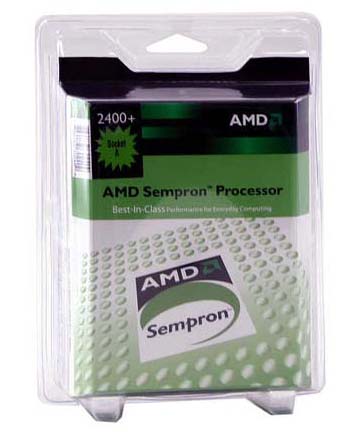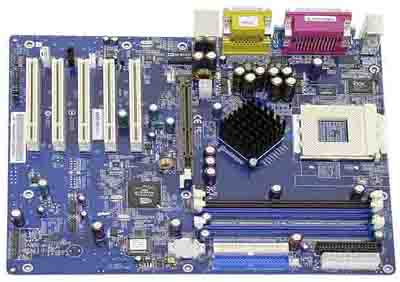Buyer's Guide - Entry Level, October 2004
by Jarred Walton on October 6, 2004 12:05 AM EST- Posted in
- Guides
CPU and Motherboard: Budget Office
For many years, if you wanted to keep up with computing trends you had to be willing to upgrade. This could range from replacing a few parts to purchasing an entirely new system. While that might not be a problem for some, for others it was a difficult proposition. Back in the 80s and 90s, buying a new computer every year or two could cost as much as a used automobile (although reliability might be a concern). Thankfully - depending on whom you ask - things have started to slow down. Many businesses continue to run two or three year old PCs with no real need to upgrade. Any processor running 1 GHz or faster is more than sufficient for surfing the net, writing email, and doing miscellaneous office work. It may not set any speed records, but other than an initial delay while starting up, most office applications spend most of their time waiting on the user.
Office CPU: AMD Sempron 2400+ 256K 1.67 GHz 333 MHz bus
Price: $65 shipped (Retail)
Our recommendation for this month's budget CPU goes to the AMD Sempron 2400+. The Sempron is basically a tweaked version of the venerable Athlon XP Thoroughbred core. Do not let the names confuse you; the Sempron family is meant to compete with the Intel Celeron line of processors and it actually runs at the same speed as the Athlon XP 2000+. However, the Sempron does use a faster 333 MHz bus, which can improve performance slightly, and since the two chips are basically the same price, there is little reason not to opt for the faster bus.
Should you wish to spend a little more on a faster processor, the Athlon XP 2500+ is still a reasonable purchase at roughly $25 more than the Sempron 2400+. It increases clock speed and doubles the amount of cache. However, AMD has recently started to phase out the Athlon XP processors and shift production to the Sempron and Athlon 64 lines, so Athlon XP prices are starting to rise. If you really want to pick up a Barton core Athlon XP, we recommend that you act sooner rather than later - the 2500+ has gone from a low of $75 a few months back to $90.
The Celeron D processor from Intel is also available at relatively low prices, but the price/performance ratio is usually lower than Athlon XP/Sempron. For those who simply have to run an Intel CPU, they are a reasonable alternative. Intel motherboards also tend to cost a little more, so the net result is that $20 will buy a Celeron D 320 and i865PE motherboard which may be slightly faster than the Sempron 2400+. The same $20 would also buy an Athlon XP 2500+, which would be another bump up in speed from the Celeron D 320. We recommend that you stay away from the older Celeron processors, however, as they use a slower bus and have 128K of L2 cache, which really hurts their performance.
Choosing a motherboard in this price segment is extremely difficult. Socket A has been around for over four years now and there have been dozens of chipsets both with and without integrated graphics. If saving money is your top priority, you might want to find an Nforce2 IGP motherboard, as it remains to this day to be one of the best integrated graphics solutions. Prices for these motherboards tend to be around $70 to $80. You will also find numerous refurbished motherboards available at a discount, but we prefer to stick with new models with their longer warranties.

Office Motherboard:Shuttle AN35N-Ultra
Price: $58 shipped
Shuttle gets the nod for our budget motherboard this time, as it includes more high-end features while still providing good reliability and performance. There may be other motherboards that are 1 or 2% faster, but they tend to cost more. The Shuttle features the more advanced Nforce2 Ultra chipset, which provides support for dual-channel memory. Should you be willing to spend a little more money, there are dozens of other motherboards that will work equally well and include additional features like SATA, IEE1394 (Firewire), RAID, and higher quality audio. However, none of those features are necessary and they increase the price slightly.
Update: If you read this guide earlier, you may have seen the Asus A7N8X-X recommended. Some of our readers were good enough to remind us that this board does not support dual-channel RAM. While it might only make a 3 to 5% difference in performance, the Shuttle supports this feature and costs less, and we have no problem wiht recommending it as in place of the ASUS. Abit, Albatron, ASRock, Chaintech, MSI, and quite a few other companies provide good motherboards at very low prices. The only feature that we still insist on for any socket A motherboard is that it use an Nforce2 chipset. Not even the new KT880 is able to fully match the performance of the Nforce2, and since they remain roughly the same price, why settle?










53 Comments
View All Comments
JarredWalton - Monday, October 11, 2004 - link
52 - ??? If you have such a high-end graphics card, are you actually thinking about pairing it with a budget systesm? Anyway, yes, it should work, unless it's an AGP Pro graphics card and your motherboard doesn't have a Pro slot. A 550W PSU should be sufficient, regardless. Anyway, you ought to look into getting an Opteron, Athlon 64, or Pentium 4 to go with that card. :pnurazlanshah - Sunday, October 10, 2004 - link
can i use 3DLabs Wildcat Realizm 200 8x AGP 512MB G-DDR3 ($1500) with my NF2 8xagp motherboard even if i have 550w power supply?MasterFlash - Friday, October 8, 2004 - link
Nice article. I like your choice of components. My comp is similar to your recommendations: Antec SLQ-3700, Biostar MN7CD Pro mobo, Athlon XP 2500+, 2x512Mb DDR400 Crucial RAM, ATI Radeon 9800 Pro, 160Gb Seagate HDD, Toshiba DVD drive, generic 19" CRT.JarredWalton - Friday, October 8, 2004 - link
#49 - Foxconn and CasEdge have been suggested in our past budget guides, so I wanted to branch out a bit. :) I'm not too keen on their look, either, but that's just me.Bulldog66209 - Friday, October 8, 2004 - link
I've found that Foxconn/Supercase/CasEdge toolless cases offer good value, are easy to work with, and many are available with truly usable 400 watt power supplies. The local Micro-Center recently had a CasEdge TU-155 on sale for $31. The included power supply rated as capable of supplying 28 amps of 3.3V, 40 amps of 5V, and 17 amps at 12V at a nominal 400 watts. This compares favorably to the Antec which, although only rated at 350 watts, provides 28 , 35, and 16 amps.spartacvs - Friday, October 8, 2004 - link
To #41What the hell do you put on those HD? I have a 40Gb: few games, few applications, few videos, few mp3 and some small softwares (k9, avant browser, etc). It's only 2/3 full. And when it's 3/4 full, it just mean it's time for a little cleanup. Sure you can easily overload 2 x 120 Gb but your need are certainly not what most of the peoples needs.
mino - Friday, October 8, 2004 - link
#45 Nicely said.I completely agree,
It just seems to me it's very important to explicitly say what you mentioned here in your post.
It's beacause there is a HUGE amount of people who save those $20 or so, just because they have no idea what the result may be. The worst(not rare) case is, when such a person is a white-box builder...
Other than that I forgot to mention in my previous post that this guide is MUCH better then last one(not saying that was bad).
Keep good work Jarred.
And one suggestion for case to consider - since I think for value machine reliability is FAR more important than look - I recommend this YeongYang Cetus YY-5601 as an alternative with PSU I mentioned before.
We have been buying only these cases for a year now on and they ones of the best in $50-60 range.
they're available for inastance here http://store.yahoo.com/directron/yy5601.html
Ivo - Friday, October 8, 2004 - link
The review is very nice and useful but several additional aspects could be addressed too:1. The Video/Audio performance for 'Home entertainment' (without gaming - for older buyers :-).
2. The Cool & Quite (Eco) features of the components and systems.
3. The micro-ATX SFF systems (not barebones) for LAN-parties, Home-PCs etc.
4. The LCD-displays.
5. The long-term price (future software compatibility) of the systems.
In that sense, possibly, only systems with Athlon64 CPUs (with good cooler) are really interesting.
JarredWalton - Thursday, October 7, 2004 - link
Regarding several of the case comments, that's pretty much what I had in mind. I've built quite a few PCs for friends, family, and even myself. The downsides to the cheaper cases often more than outweigh the $20 or so you might save. Heck, if it were me, I would even try to get up to the SLK-3700 or Sonata cases by Antec (although oddly enough I prefer the 3700 over the Sonata - other than the PSU, of course). They're *so* much nicer to work with than a lot of the other sub-$100 cases.Really, cases are a personal choice. What I often consider gawdy or ugly, some people think is "l33t". Conversely, what I think is simple and elegant others will say is boring and dull. Buy what makes you happy, but if you get a cheap, generic PSU and it fails after a few months, don't say we didn't warn you!
Anyway, thanks to all for the kind comments. I'll look at including some other miscellaneous recommendations in the future. I do have to say that after reading Kris' MythTV articles, I've been itching to build a TiVo-esque PC. I just keep repeating to myselft, "You do NOT need another PC... you do NOT need another PC..." Heheh.
Neurorelay - Thursday, October 7, 2004 - link
Whoops, I see the 6600...okay, mistook the number. :)